May 1, 2020
Air Date: May 1, 2020
FULL SHOW
SEGMENTS
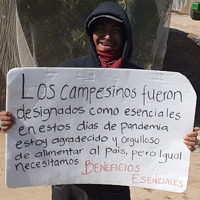
Farmworkers and the Virus
View the page for this story
Migrant farmworkers are considered essential workers during the COVID-19 pandemic and if they don't continue to tend and harvest the crops that feed America, there will be food shortages. Many farmworkers face special risks during the pandemic, as they work in crowder's conditions and more than half of them are undocumented, with poor access to healthcare and federal aid. Marc Grossman, a spokesperson for United Farm Workers of America, joins Host Bobby Bascomb to talk about how the COVID-19 pandemic is affecting migrant farmworkers in the United States. (08:39)
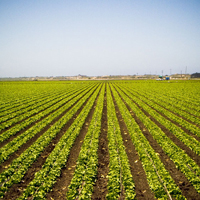
A Migrant Farmworker Shares COVID-19 Fears
View the page for this story
Farmworkers must continue to work in close quarters with others, but some are provided with only soap and water to shield against COVID-19. And if they get sick, many don’t have any health insurance. From Mexico Living on Earth’s Paloma Beltran reports what she learned from speaking with a longtime Mexican farmworker in California about his fears and frustrations about working in the midst of the (06:08)

Beyond the Headlines
/ Peter DykstraView the page for this story
In this week’s installment of Beyond the Headlines, Environmental Health News Editor Peter Dykstra updates Host Steve Curwood on the planet’s ominous climate change signals. Meanwhile, the plastics industry has won a victory with rollbacks of single-use plastic bag bans in California. Finally, the pair takes a look back at this week in 1940, when the German forces during World War II seized a hydroelectric dam and heavy water processing facility in Vemork, Norway, as part of their bid to make an atom bomb. (04:43)
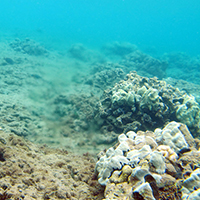
Supreme Court Clean Water Win
View the page for this story
In a key decision for environmental law, the US Supreme Court has handed down new guidance on when indirect sources of water pollution require a Clean Water Act permit. Vermont Law School Professor Pat Parenteau joins Host Bobby Bascomb to discuss how the 6 to 3 decision came about, and precedent for environmental law. (08:32)

Note on Emerging Science: The Days the Earth Stood Still
View the page for this story
As people around the world self-isolate and non-essential work is put on hold, the Earth has grown quieter. Seismographic data show that ambient vibrations caused by human activities, have decreased by 30 to 50% since stay-at-home orders went into effect. Living on Earth’s Isaac Merson reports. (02:25)
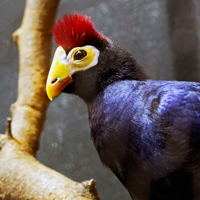
Zoos and Aquariums Online
/ Aynsley O'NeillView the page for this story
With shelter-in-place orders affecting much of the country, zoos, aquariums, and wildlife centers have had to close their doors. Many of these facilities have gone online to continue their mission with virtual visits, exhibit livestreams, and enrichment programs. Living on Earth's Aynsley O'Neill reports. (04:59)
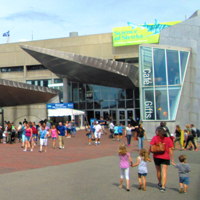
Behind the Quarantine at the New England Aquarium
View the page for this story
Across the country, animal care facilities are facing the question of how to care for their animals without visitor revenue during the coronavirus shutdown. Vikki Spruill, the President and CEO of the New England Aquarium in Boston, joins Host Steve Curwood to explain how her staff is taking care of more than 20,000 animals during the lockdown. (06:19)
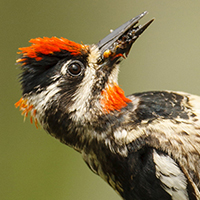
Sap-Iens: Yellow-Bellied Sapsuckers
/ Mark Seth LenderView the page for this story
In the far North, the short season for raising young means nesting birds have to work fast. Living on Earth's Explorer in Residence, Mark Seth Lender, marvels at the speed and diligence with which a pair of yellow-bellied sapsuckers build and maintain a nest. (04:19)
Show Credits and Funders
Show Transcript
HOSTS: Bobby Bascomb, Steve Curwood
GUESTS: Marc Grossman, Pat Parenteau, Vikki Spruill
REPORTERS: Paloma Beltran, Peter Dykstra, Mark Seth Lender, Isaac Merson, Aynsley O’Neill
[THEME]
CURWOOD: From PRX – this is Living On Earth.
[THEME]
CURWOOD: I’m Steve Curwood.
BASCOMB: And I’m Bobby Bascomb.
Immigrant farmworkers are considered essential during lockdown but working conditions make them vulnerable to COVID-19.
GROSSMAN: We've all seen the shelves in supermarkets on paper goods and toilet paper and so on empty but imagine if the pandemic takes hold in the farmworker community what would happen to the nation's food supply.
CURWOOD: Also, the unique challenges facing zoos and aquariums amid the Coronavirus outbreak.
SPRUILL: Typically if a crisis happens in one part of the country, say a storm or a hurricane or something, we're a very tight-knit network of institutions who help one another with taking the animals if we have a particular challenge or whatnot. This is a little different because we're all in the same boat.
CURWOOD: That and more this week on Living on Earth – Stick Around!
[NEWSBREAK MUSIC: Boards Of Canada “Zoetrope” from “In A Beautiful Place Out In The Country” (Warp Records 2000)]
[THEME]
Farmworkers and the Virus
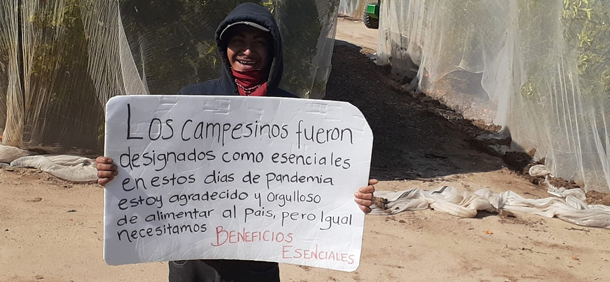
A campesino holds up a poster that reads “Field workers were designated as essential during the pandemic. I am thankful and proud to feed the country, but we also need essential benefits.” (Photo: Courtesy of UFW)
CURWOOD: From PRX and the Jennifer and Ted Stanley Studios at the University of Massachusetts Boston, this is Living on Earth. I’m Steve Curwood.
BASCOMB: And I’m Bobby Bascomb.
Meat supplies are getting tight in the US as processing plants have become hotspots of the COVID-19 virus, with at least 17 workers dead, thousands more sickened and dozens of meatpacking plants shut down. Meatpacking assembly lines are crowded with low wage workers, many of them are undocumented immigrants, much like the workers who harvest and process the produce grown in the US. United Farm Workers spokesman Marc Grossman says farmworkers are also at high risk in the face of the pandemic. Marc Grossman joins me now, welcome!
GROSSMAN: Pleasure to be with you.
BASCOMB: So please tell me first about the average farmworker in the United States. Who are they? Where are they from and what's their daily life like?
GROSSMAN: Well, even before the pandemic hit farmworkers faced daunting challenges. We know that, you know, they're mostly immigrants today, in very low paying jobs with the exception of a small number that are protected by union contracts. They have few if any benefits, they must live, commute and work under very close quarters often in substandard and unsanitary and crowded conditions. We know from the US Department of Labor that at least half are undocumented, which makes them even more vulnerable to abuse. But all of these factors make them uniquely vulnerable to the pandemic. And when the pandemic began, the UFW first went directly to individual growers who were under a union contract and some companies under contract change, picking practices and styles. Even if productivity was reduced to enforce social distancing, implemented other social distancing practices had training including crew meetings to educate workers about what they should do. But those responses only highlight the urgent need for more widespread action at non-union companies and there although some employers are stepping up, many are not. And you know, we've all seen the shelves of the supermarkets, on paper goods and toilet paper and so on empty, but imagine if the pandemic takes hold in the farmworker community what would happen to the nation's food supply?
BASCOMB: So those sound like really good common-sense precautions to take for essential workers who again, you know, are providing food for the country, but how common would you say those types of precautions are within the industry?
GROSSMAN: You know, we have an expression that the laws on the books are not necessarily the laws in the fields. California leads the nation in protective laws and regulations for farmworkers. Everything from minimum wages and hours to pesticide protections to sexual harassment, but there is too often a gap between what the laws and the regulations and the government agencies require and the actual enforcement and implementation in the fields.
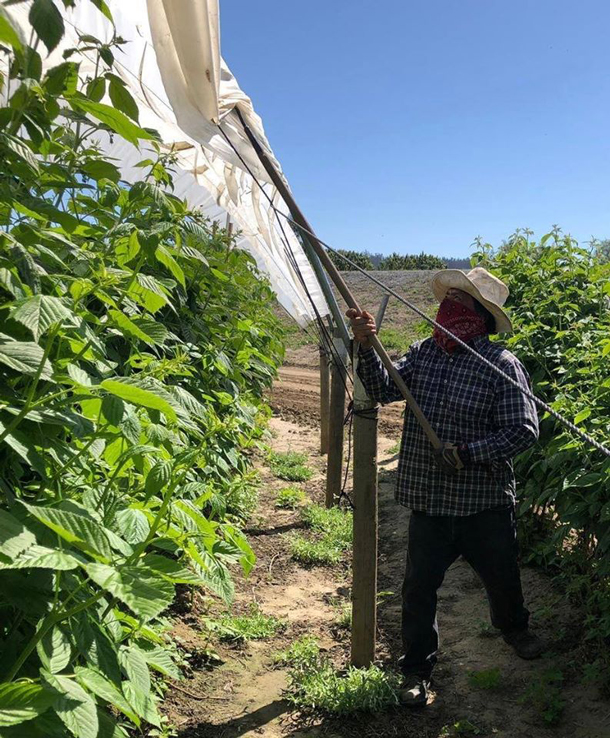
Raspberry production in Watsonville, California. Raspberry production often takes place in June-July. (Photo: Courtesy of UFW)
BASCOMB: And a lot of these workers are here temporarily from other countries and I assume have temporary housing. What does that look like for them?
GROSSMAN: Well, the housing and these are H2A guest workers is usually barracks-style housing, where people are packed in closely together in beds or bunks. It's very difficult to enforce social distancing. And if someone gets sick, unless special preparations are made to quarantine them, then that becomes a big challenge too.
BASCOMB: And if they do get sick, do they have access to health care while they're here?
GROSSMAN: No, you know that that's a big problem because the great majority of farmworkers and non-union companies do not have health care. And, you know, one of the problems on paid sick leave is that some growers have made it difficult for workers to actually claim it. Sometimes they require a doctor's note. But since most workers have no health care, they don't have doctors, or some companies have a waiting period 30, 90 days before new workers can claim sick leave benefits if they exist. So all of those things represent challenges that must be overcome quickly if paid sick leave is going to become a reality.
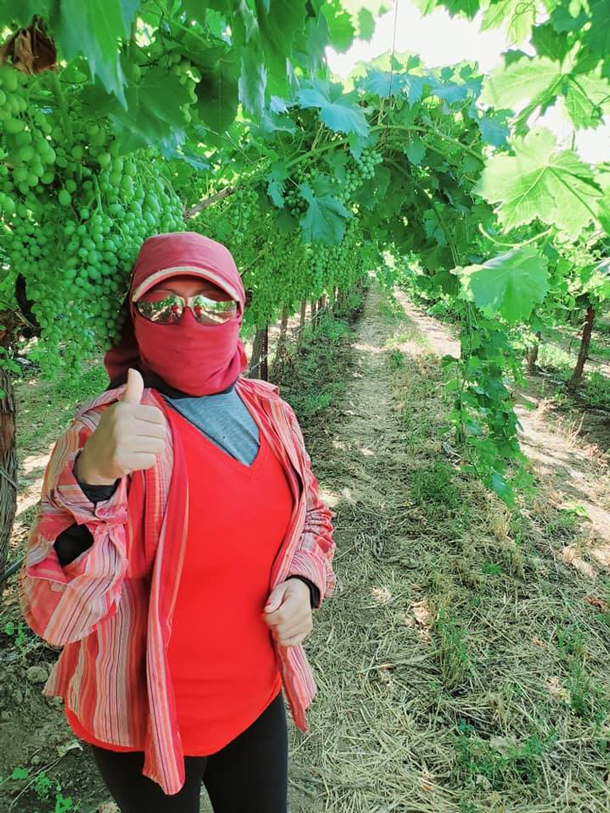
A campesina harvesting grapes on a California farm. California grapes form part of an industry approximately worth $2 billion. (Photo: Courtesy of UFW)
BASCOMB: Now, you said that as many as 50% of farmworkers are here illegally, how possible is it then that they're putting themselves at even higher risk of deportation right now going to work when there are so many fewer people out and about in the world? Is that something you're concerned about? You know?
GROSSMAN: When on the UFW social media platforms, many workers respond to the news that they're now officially considered essential workers with anger, because they say, well, now they think we're essential workers. But they don't have essential benefits and protections that other essential workers have enjoyed for some of them for generations, minimum wages and hours, The Fair Labor Standards Act the federal law, from the New Deal granting industrial workers something as simple as overtime after eight hours a day excludes farmworkers, back in 1938. And it was only in two 2016 that the UFW got a law passed in California that provides phased in overtime after eight hours a day over a four year period. So these essential workers often do not have the essential benefits that protect everybody else. Hazard pay, hundreds of thousands of workers in the retail food industry have been provided sometimes $1, $2 an hour or more in additional pay, because they're putting their lives at risk by going to work stocking the supermarket shelves. Well, farmworkers are also essential workers and they take their lives in their hands when they go to work. Why shouldn't they get the same recognition?

Cesar Chavez and Larry Itliong were leaders in the Delano Grape strikes of 1965. The peaceful strike involved both Mexican and Filipino farm workers protesting against the exploitation of farmworkers by Delano-area vineyards. Thus began a five-year grape strike and later a three-year international boycott of California table grape. (Photo: Courtesy of UFW)
BASCOMB: And how concerned are they that while going to work and performing this essential service, they might get deported on their way? I mean, is ICE, it's still targeting these workers just as much as they were before the pandemic?
GROSSMAN: I believe ICE has indicated that they're holding up on enforcement actions in the interior of the country. But remember, for years there has been a palpable fear by foreign workers just in going to work. So, you know that in addition to the danger of exposing themselves and their family members to infections, many undocumented farmworkers find it very difficult to abandon their fear of being apprehended and deported. You know, last December, the US House of Representatives passed a bill for the first time in decades an agricultural immigration bill that would allow undocumented farmworkers already in this country to earn the legal right to permanently stay by continuing to work in agriculture. The bill is now in the United States Senate, and it was passed on a bipartisan vote, 34 Republicans in the House voted for the measure and it would go along way in eliminating the fear and the terror that undocumented farmworkers live with every day.
BASCOMB: So I mean, it seems like we're in a situation where these farmworkers are considered essential today but could still be deported six months from now when hopefully this pandemic has passed and things go back to normal. Is that really what we're looking at?
GROSSMAN: We hope that Americans use the pandemic as an opportunity to really examine themselves and their society, and equity issues like the denial of essential rights and benefits to farmworkers. That has gone on for too long. So we're hoping that people use this as an opportunity for reflection, much-needed reflection on eliminating the inequities and the injustices that have plagued farmworkers and other people who are vulnerable.
BASCOMB: Marc Grossman is a spokesman for United Farm Workers and former assistant and speechwriter for Cesar Chavez. Marc, thank you so much for taking this time with me today.
GROSSMAN: My pleasure. Thank you.
Related links:
- Read more about the California Farm Bureau and the COVID-19 pandemic
- Informational Video by the California Farm Bureau for Farmworkers
- The California Department of Industrial Relations Division of Occupational Safety and Health is the state government agency that enforces safety regulations in California.
- Learn more about the non-union organization Lideres Campesinas
- Read the Lideres Campesinas Letter to Governor Newsom, urging the state to allow healthcare professionals to conduct educational orientations on COVID-19 in the fields
- Link to United Farm Workers of America
A Migrant Farmworker Shares COVID-19 Fears
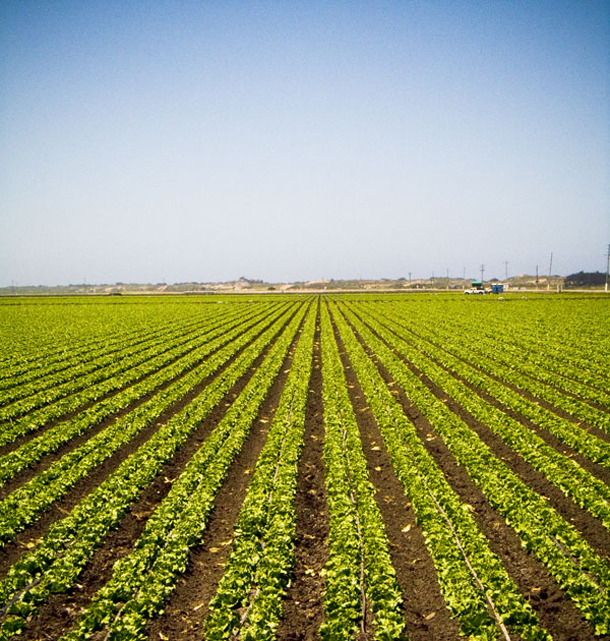
The California agricultural industry accounts for more than 13% of the United States' agricultural value. (Photo: Liji Jinaraj, Flickr, CC BY SA 2.0)
BASCOMB: For more, I’m joined by Living on Earth’s Paloma Beltran. Paloma is in Mexico now, riding out the pandemic with her family and has been digging into this story of the Coronavirus and agricultural workers.
Hi Paloma, how are you?
PALOMA: Hi Bobby, I’m good, happy to be safely isolating with my mom and sister. How about you?
BASCOMB: Good, lots of time with my husband and kids.
PALOMA: Nice…
BASCOMB: So, you recently spoke with a farmworker who is struggling through the pandemic. Tell me about him, please.
PALOMA: Right, I talked with a man named Jesus. He is originally from central Mexico but has been an agricultural worker in California for almost 20 years. He makes $13 an hour before taxes at a non-union farm and is just about to start the cherry-picking season then he’ll move to grapes in June. But of course, that’s only if there is enough demand for those products. Already his hours have been cut from 10 hours a day to 8. And he’s really worried about the economy and hopes that it opens up soon.
JESUS: “Si nosotros no trabajamos no comemos."
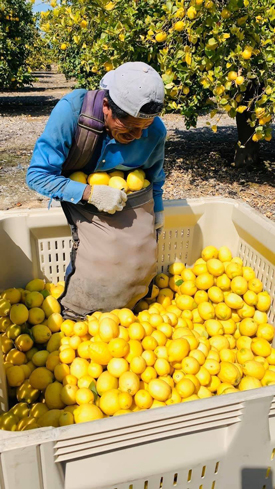
The San Joaquin Valley citrus region has more than 20,000 lemon harvesters. There are more than 700,000 agricultural workers in California, all of whom are considered essential workers during the coronavirus pandemic. (Photo: Courtesy of UFW)
PALOMA: He says, “If we don’t work we don’t eat.” And Jesus is not just worried for himself. He sends money back to his wife and kids In Mexico each month and that’s their main source of income.
JESUS: “Espero dios y no me enferme y pues yo necesito trabajar para poder mantener a mi familia”
PALOMA: He says, “I hope God spares me from getting sick because I need to work to provide for my family.” He’s really scared.
BASCOMB: Wow, that sounds so stressful. What is he doing to keep himself safe and avoid getting the virus?
PALOMA: Well, I was shocked to hear Jesus say that his employers aren’t providing anything other than soap and water to help him and his co-workers stay safe.
JESUS: “Nosotros de nuestra propia cuenta tenemos que llevarnos pañuelos para protegernos y cuidarnos nosotros mismos”
PALOMA: He’s saying, “we have to buy our own facemasks or wear scarves to protect ourselves and we wash our hands as much as possible.” Some employers are “encouraging” social distancing but it's really hard to distance yourself when you are working in the agriculture industry. It’s a hands-on job that requires teamwork and face to face interaction.
JESUS: “Nosotros trabajamos en cuadrillas de 15-20-25 personas pues si tenemos miedo a enfermarnos. Si nosotros nos enfermamos no tenemos con qué pagar lo que es el seguro médico."
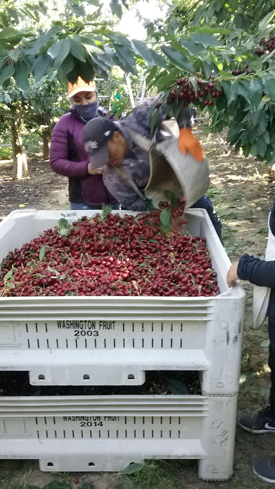
The San Joaquin Valley is the largest cherry production region of California. Most of the United States’ vegetables, fruits, and nuts are grown in California, making California agricultural workers an integral part of the nation's food supply. (Photo: Courtesy of UFW)
PALOMA: He says, “we work tight groups of 15-20-25 people and everyone works closely together, so everyone is scared of getting sick. We don’t have health insurance, if we get sick we would have to pay health care costs out of pocket from the little savings we have.” And I think he feels a bit of resentment about the lack of support. He says the United States is highly dependent on immigrant farm workers like him and he contributes to the economy.
JESUS: “Nosotros también en nuestro cheque nos descuentan lo que es seguro, lo que es médical, todo lo federal también. Osea nos descuentan igual que una persona que tiene documentos ”
PALOMA: Farmworkers pay taxes just like everyone else, he says, including federal taxes and so he doesn’t understand why the federal government is not supporting them as essential workers during this pandemic.
BASCOMB: Jesus is just one person but it sounds like his story is pretty common across the industry.
PALOMA: Yes, for sure. Jesus says he’s also worried for people who work in managerial roles and packing facilities across the commodity chain. And as we’ve mentioned earlier more than half of the fieldworkers in the US are like Jesus and undocumented so they face very similar challenges. Jesus told me that he talks a lot with his co-workers about the virus and fear of getting sick and losing their jobs. And they’re just feeling sad, you know, the missing family that’s so far away.
BOBBY: Right, such a difficult position to be in. Well, thanks for bringing us his story, Paloma.
PALOMA: You’re welcome. Stay safe there.
BOBBY: You too! I’ll talk to you soon. That’s Living on Earth’s Paloma Beltran from her home in Mexicali, Mexico.
Related links:
- Inside Climate News | Essential but Unprotected Farmworkers Live in Fear of Covid-19 but Keep Working
- Los Angeles Times | Farmworkers face coronavirus risk: ‘You can’t pick strawberries over Zoom’
- National Geographic | Farmworkers Risk Coronavirus Infection to Keep U.S. Fed
[MUSIC: Renaissonics, “Branle Gay-Branle De Poictou-Un Flambeau, Jeanette, Isabella, Patapan” on Carols For Dancing, traditional French and English carols, WGBH Recordings]
CURWOOD: Coming up – Environmental activists get a big win at the US The Supreme Court. That’s just ahead on Living on Earth.
ANNOUNCER: Support for Living on Earth comes from Sailors for the Sea and Oceana. Helping boaters race clean, sail green, and protect the seas they love. More information at sailors for the sea dot org.
[CUTAWAY MUSIC: Ottmar Liebert, “Dancing Under the Moon” on Borrasca, by Ottmar Liebert, Higher Octave Music]
Beyond the Headlines

Tropical Depression One-E formed in the Eastern Pacific south of Baja California on April 25th, the first recorded tropical depression in April in that region. (Photo: National Hurricane Center/Central Pacific Hurricane Center/National Oceonographic and Atmospheric Administration, Public Domain)
BASCOMB: It’s Living on Earth. I’m Bobby Bascomb.
CURWOOD: And I’m Steve Curwood
CURWOOD: And today for our look beyond the headlines we turn as usual to Peter Dykstra. Peter's an editor with Environmental Health News that's ehn.org and dailyclimate.org, on the line from Atlanta, Georgia there, Peter, how are you doing?
DYKSTRA: Hey, Steve, one piece of news that came out this past week is a little bit disturbing in terms of what we might expect for hurricane and typhoon season because on April 25th, the first Tropical Depression in the eastern Pacific that's ever happened in the month of April, briefly showed up south of Baja California. It didn't last more than a day, it never touched land, but it did touch the worry button for people who see the hurricane and typhoon season, potentially expanding.
CURWOOD: And on the other side, in the Gulf of Mexico, there's been unusually warm water that's already been blamed for the spate of really difficult tornadoes we've seen in the southern United States. I guess things are getting warmer.
DYKSTRA: Things are getting warmer. And that's been a trend not only in the Gulf of Mexico but in the Atlantic coast off the southeast US for years. There's also information this past week from Europe, that 11 of the 12 hottest years ever recorded on the European continent have happened since the year 2000.
CURWOOD: Hmm, what else do you have for us today? Any better news?
DYKSTRA: Not today, Steve. Sorry. We'll go back to 2016. When California prohibited the use of those thin, single-use plastic bags at stores, they instituted a 10 cent fee if customers don't bring their own bags, but with Coronavirus, dominating the news and dominating public concern. The industry pushed back and they got California to roll back that fee for 60 days because the industry says customers bags could be a transmission device to bring Coronavirus to grocery workers.
CURWOOD: Hmm. Well, that reminds me of the year 2001 when the chemical industry used 9/11 to rollback those disclosure laws that had been passed so that local residents and fire departments and environmental journalists could know what chemical plants were using and storing.
DYKSTRA: That's right. There's a history as you suggest of big industries that had been fighting tooth and nail against regulation, using a disaster, to blunt that regulation. It's a cynical twist on that old notion that every crisis is someone's opportunity. Also, the plastics industry, citing Coronavirus, has asked Congress for a billion-dollar bailout even though the price of natural gas, the main feedstock for plastic, is at a major major low.
CURWOOD: Okay, Peter well now let's take a look back in history.
DYKSTRA: We're going to do like a lot of cable TV channels do. We're going to obsess for just a minute about World War Two and go back to May 3rd, 1940. And as part of Nazi Germany's blitzkrieg into Norway, they seize the heavy water Research Facility at Vemork in Norway.

Vemork Hydroelectric Power Station in Norway was built in 1934 and seized by occupying German troops during the blitzkrieg in 1940 for use as a heavy water production facility critical to making atom bombs. (Photo: Sigurd Rage, Flickr, CC BY-NC-ND 2.0)
CURWOOD: So of course, heavy water is integral at least to certain processes known as nuclear fission, in other words, making an atom bomb.
DYKSTRA: That's right. It's a process that was new at the time. They replaced hydrogen with a different heavier isotope of hydrogen called deuterium. They only had about a half-ton of it made over years: Norway was looking into it for other purposes, the Nazis were interested in it as a precursor to making nuclear weapons, and that hydroelectric plant at Vemork when it was built in 1911, it was the biggest in the world, but it produced enough power to produce heavy water and become a target of opportunity for the Nazis.
CURWOOD: And speaking of the target of opportunity, there have been many movies made about the raid on this plant, which set the Nazis back at least many months, if not a year, and gave the advantage ultimately to the United States to be the first with the atom bomb.
DYKSTRA: Yeah, there was a raid in 1943 by Norwegian commandos and commandos from other allied countries to liberate the Vemork plant, it set the Nazis back. They of course, never built nuclear weapons, and think how different things would be if they had.
CURWOOD: Peter Dykstra is an editor with Environmental Health News, that's EHN dot org and Dailyclimate.org. Thanks, Peter. We'll talk again real soon.
DYKSTRA: All right, Steve, thanks a lot. Talk to you soon.
CURWOOD: And you can find more about these stories on the Living on Earth website. That's LOE.org
Related links:
- Click here to read more about tropical depression One-E
- The Intercept | “Big Plastic Asks For $1 Billion Coronavirus Bailout”
[MUSIC: Cyrus Chestnut, “Blessed Assurance” on Spirit, by Cyrus Chestnut, Jazz Legacy Productions]
Supreme Court Clean Water Win

Degraded coral reefs at Kahekili Beach Park, west Maui, Hawai‘i. A 2018 USGS study found little evidence of live coral near groundwater seeps. (Photo: Peter Swarzenski, USGS. Public domain)
BASCOMB: The Clean Water Act is designed to protect lakes, rivers, and the ocean from pollution, and the law states any direct discharge into those waters requires a federal permit. But when sewage from a municipality in Hawaii that was being pumped into the ground started leaking out into the ocean officials said no permit was needed as it was not a direct discharge. And though this view was championed by the Trump Administration the US Supreme Court recently ruled 6 to 3 that on a functional basis the treated sewage was being dumped in the ocean in violation of the law. The ruling could set a key precedent for years and here to explain is Vermont Law School, Professor Pat Parenteau. Pat was part of a group of law professors that filed an amicus, or “friend of the court”, brief in the case. Hey Pat, welcome back to Living on Earth!
PARENTEAU: Thank you, Bobby, good to be with you.
BASCOMB: So Pat, tell me about the Clean Water Act case in the County of Maui vs. Hawaii Wildlife Fund. What was the Court asked to decide here? And what did they decide?
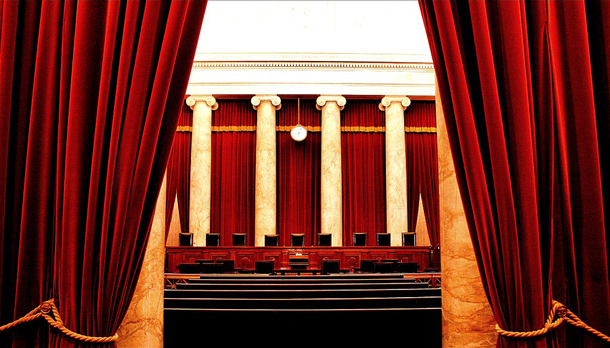
The Supreme Court of the United States is conducting its business remotely during the COVID-19 pandemic and will hear oral arguments by phone this May. (Photo: Phil Roeder, Wikimedia Commons CC BY 2.0)
PARENTEAU: Yes, it was a very important Clean Water Act case. And the question was, what do you do when you have an injection well, that is injecting treated sewage into the groundwater, which then flows into the ocean and causes all kinds of problems. This particular discharge in Maui was impacting a very important coral reef and the reef was deteriorating. This is also a very popular surfing beach and swimming beach. And of course, treated sewage still has a certain amount of bacteria. So there was that question as well. The legal question was if you discharge through the groundwater into the ocean, is that the kind of activity that requires a permit under the Clean Water Act? The County of Maui said it didn't; the State of Hawaii didn't require a permit. And this activity has gone on for many years. And finally, a lawsuit was brought, what we call a citizen suit, by a group of conservationists in Hawaii. And they convinced the courts that even though it was an indirect discharge to the ocean, it was still one that required a permit. And so this issue had to go all the way to the United States Supreme Court, because we've had other circuit courts who ruled in the opposite way, saying that it must be a direct discharge to surface water in order to require a permit. So that was the question the Supreme Court had to resolve.
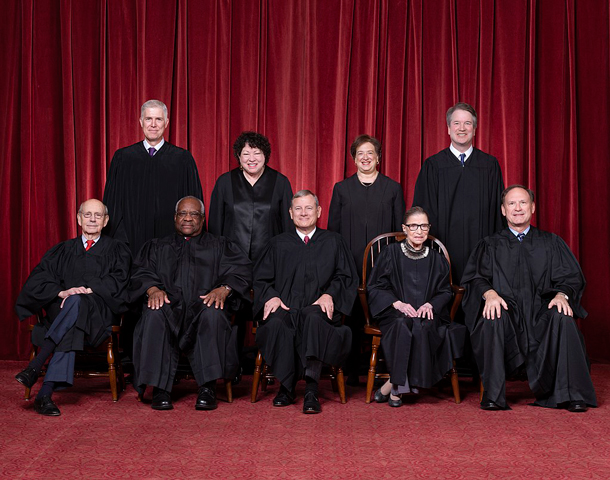
The Roberts Court, from November 30, 2018. Seated, from left to right: Justices Stephen G. Breyer and Clarence Thomas, Chief Justice John G. Roberts, Jr., and Justices Ruth Bader Ginsburg and Samuel A. Alito. Standing, from left to right: Justices Neil M. Gorsuch, Sonia Sotomayor, Elena Kagan, and Brett M. Kavanaugh. (Photo: Fred Schilling, Collection of the Supreme Court of the United States)
BASCOMB: And what did they decide in this case?
PARENTEAU: Well, what they decided was to kind of split the baby. The environmental groups were arguing that anytime that you could trace a discharge into groundwater that ended up in surface water, that should require a permit. And the Ninth Circuit Court of Appeals agreed with that and called it the "fairly traceable" test. The petitioners, the County of Maui joined by EPA and the Trump administration, argued, no; no indirect discharge should require a permit, it would have to be a pipe that you know, discharged directly into the ocean in order to require a permit. The Supreme Court came down in the middle and said, We don't agree with the Ninth Circuit in this broad test of "fairly traceable". But we also don't agree with the County and with the Trump administration that only direct discharges should be regulated. And Justice Breyer wrote an opinion, and he came up with a new test. He called it the "functional equivalent" test, and what he meant was, if the discharge through groundwater is the functional equivalent of direct discharge to the ocean, that's going to require a permit. And what he expressed was a concern that if you didn't capture some of these indirect discharges, that would create a big loophole in the law, and it would allow people to get around having to get a permit by simply moving their pipe back from the river or the lake or injecting waste into the groundwater, even though they knew it was going to go right into the surface water.
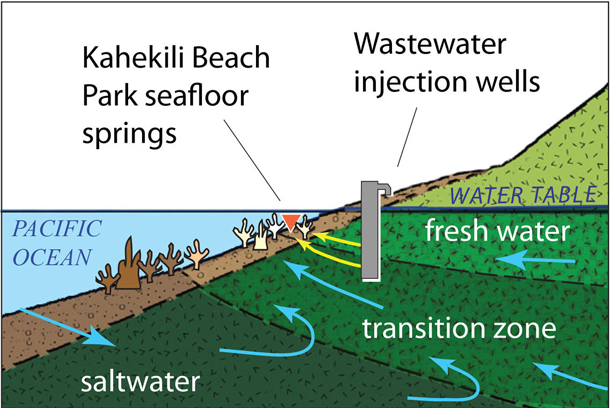
A USGS diagram showing how injected wastewater from the Maui facility travels to seafloor springs among a nearby coral reef. (Photo: USGS, Public domain)
So Justice Breyer wrote the opinion; the key here was Chief Justice Roberts joined the opinion, and even more surprisingly, Justice Kavanaugh join the opinion. So this is really the first time that Justice Kavanaugh has sided with the more liberal wing of the Court in a decision that really gave at least a partial victory, I think, to the environmental groups.
BASCOMB: Now, what are some other examples of indirect water pollution situations that could be impacted by this decision?
PARENTEAU: There are quite a few. There are a lot of these injection wells that sewage treatment plants use to get rid of their, their treated effluent rather than discharge them directly to the river. So there's quite a few of those around the country. Another big category is these coal ash pits all through coal country in the Southeast part of the United States, the Midwest. There's a legacy now of all this coal that we've mined and burned in power plants. And the residue of that is this toxic ash material, which is just dumped, really, in many places, in these open pits that don't have liners. And what we're finding now is that all of this coal ash is leaching into the groundwater into the rivers. And so the question there is that when this coal ash pits leach these heavy metals down through the groundwater that is getting into the surface water, is that another form of indirect discharge requiring a permit? The courts on this question have been split, and so now we have this new test that the Supreme Court and the Maui case has come up with. And some of these cases are probably going to have to be reviewed under this new test to see whether or not some of these indirect discharges actually require a permit. So this, this case will take several years, I think, to sort out what this new test is going to look like.

Associate Justice Stephen Breyer’s opinion for the County of Maui v. Hawaii Wildlife Fund case introduces a brand-new “functional equivalence” test for whether an indirect water pollution source is subject to the Clean Water Act. (Photo: Steve Petteway, photographer for the US Supreme Court)
BASCOMB: Now, in the interest of full disclosure, Pat, you were part of a group that files an amicus brief in this case, can you tell me about that?
PARENTEAU: Yes, a group of us law professors got together and wrote a brief and had it circulated among our colleagues, both environmental law professors and administrative law professors. And we argued for a little different test, we thought a simpler approach would be to say, as long as you can establish a proximate cause between the indirect discharge and the impact on the water. You know, we cited examples of using dye tests to be sure that the same pollutant you're concerned about is actually coming from a designated or a defined point source. So we argued for the result in the case, which was, there should be some instances where these indirect discharges are regulated. We just advocated a slightly different test, one that Justice Breyer didn't think much of. And so he literally invented this functional equivalent test, it's, it's brand new.
BASCOMB: Well, it seems to have done the job, though.
PARENTEAU: I would say so. I think you have to chalk this up as an important win for water quality and the environment. And good news from a Court that -- frankly, we're all very concerned about, whenever an environmental case gets to the Supreme Court these days, we kind of hold our breath and hope for the best and, and I think, in this case, we probably got the best outcome we could have hoped for.
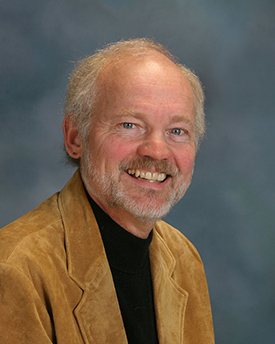
Former EPA Regional Counsel Pat Parenteau teaches environmental law at Vermont Law School (Photo: courtesy of Vermont Law School)
BASCOMB: Well, Pat, how likely is it that the EPA will enforce the Clean Water Act any differently because of this ruling?
PARENTEAU: I don't think we can count on the Trump administration to become aggressive, more aggressive in enforcing these requirements. They weren't even enforcing requirements before this decision, and with this test of functionally equivalent, I would worry that this EPA might actually take a position that something that really is functionally equivalent isn't. But future EPA administrations can, of course, take advantage of this. And even more importantly, citizen suits can use this test to bring actions against problems that EPA or the state isn't addressing. In fact, that's how this Maui case came to the Supreme Court. So it's most important, I think, for citizens and community groups to protect their sources of water quality, their sources of drinking water, when the government failed to do it.
BASCOMB: Pat Parenteau is a professor of environmental law at Vermont Law School. Pat, thank you so much for taking this time with me.
PARENTEAU: My pleasure, Bobby, thanks.
Related links:
- The Washington Post | “Supreme Court rejects Trump administration’s view on key aspect of Clean Water Act”
- Read Justice Stephen Breyer’s opinion for the case
- A USGS study found corals off the coast of the Maui wastewater facility were exposed to high levels of pollution
- About Professor Pat Parenteau
[MUSIC: Cyrus Chestnut, “Bridge Over Troubled Water” on Spirit, by Cyrus Chestnut, Jazz Legacy Productions]
Note on Emerging Science: The Days the Earth Stood Still

The earth is always vibrating, as small amplitude waves ripple across its surface and rattle up from below. (Photo: Ashok Boghani, Flickr, CC BY-NC 2.0)
CURWOOD: Just ahead, many zoos and aquariums have had to close their doors but they’ve opened an online window. But first this note on emerging science from Isaac Merson.
[SCIENCE NOTE THEME]
MERSON: As people around the globe shelter at home, an unusual calm has come to the surface of the earth.
In fact, our reduced activity and physical movement can actually be measured using seismographs, instruments used to measure the minute movements of the earth beneath our feet.
Seismographs are extremely sensitive. They sense vibrations caused by sources as varied as the wind moving across the surface of the earth, the crash of waves on the shore, the hum of pressure as gasses bubble up through cracks and seams in the crust in the earth.
And they also detect vibrations caused by human activities, such as the movement of vehicles or the pounding of industrial machinery.
[MACHINERY SOUND]
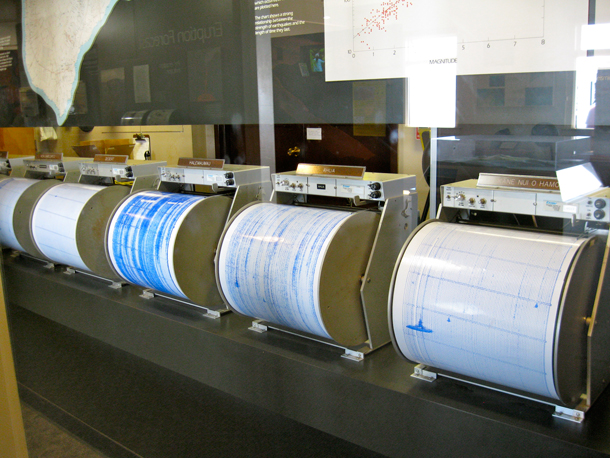
Seismographs are incredibly sensitive instruments, and can detect vibrations from sources as minute as the wind blowing across the surface of the earth. The seismograph showing all the blue ink indicates lots of vibration, which is coming from the crater rim of Hawaii’s Halema‘uma‘u Crater. (Photo: Rosa Say, Flickr, CC BY-NC-ND 2.0)
All these vibrations create a background which can be hard for earth scientists to tease apart.
But in the weeks since governments have issued orders to stay at home Seismograph data from around the world has shown a tremendous decrease in the amount of these ambient seismic vibrations.
One seismograph located at the Royal Observatory of Belgium showed a greater than 30% decrease in the total background vibrations in the weeks since Belgium instructed its citizens to stay home.
And Brussels isn’t alone. Seismographs from Los Angeles, London, and Barcelona have shown similar or even larger reductions.
Now, in the absence of some of that muddy background data, scientists may be able to gather important information about the influence of other sources of ambient vibrations, such as the exact contribution of the oceans.
[OCEAN SOUNDS]
This may help us better predict future earthquake events, especially in highly populated urban areas.
Update this morning: anthropogenic noise is still low. We also compare the median noise per weekday/hour before/after lockdown! #staysafe #stayhomebelgium pic.twitter.com/iAE1imBuEj
— Seismologie.be (@Seismologie_be) April 6, 2020
In the meantime, the relative stillness of the earth’s crust could allow seismologists to better detect seismic events happening right now,
[EARTHQUAKE SOUND]
as the signal may come through more clearly with less competing noise, like a radio signal with less static.
For Living on Earth, I’m Isaac Merson.
[SCIENCE NOTE THEME]
Related links:
- Click here to see seismic activity data from around the world demonstrating the decline in ambient seismic noise
- Nature News | “Coronavirus lockdowns have changed the way Earth moves”
- Follow @Seismologie_be to see current seismograph data from the Royal Observatory of Belgium
BASCOMB: We are spending a lot of time indoors these days. And indoor air can affect our health, creativity, and productivity. For some insight we will be hosting a free live streamed conversation with renowned public health expert Joe Allen. He’ll be talking about his new book, Healthy Buildings and exploring how we can design indoor spaces to maximize our well-being. The event is May 12 at 6:30 pm Eastern. Learn more about this and other events in our Good Reads on Earth series at our website, loe.org/events
[MUSIC: Schwey, “Sh'qweyla” on Schwey, 604 Records]
Coming up- Springtime in the North is a busy time for birds. That’s just ahead on Living on Earth.
ANNOUNCER: Funding for Living on Earth comes from you, our listeners, and United Technologies, combining a passion for science with engineering to create solutions designed for sustainability in aerospace, building industries, and food refrigeration.
[CUTAWAY MUSIC: Robert Maxwell, “Ebb Tide” (issued as a single), by Robert Maxwell, Mercury Records]
Zoos and Aquariums Online
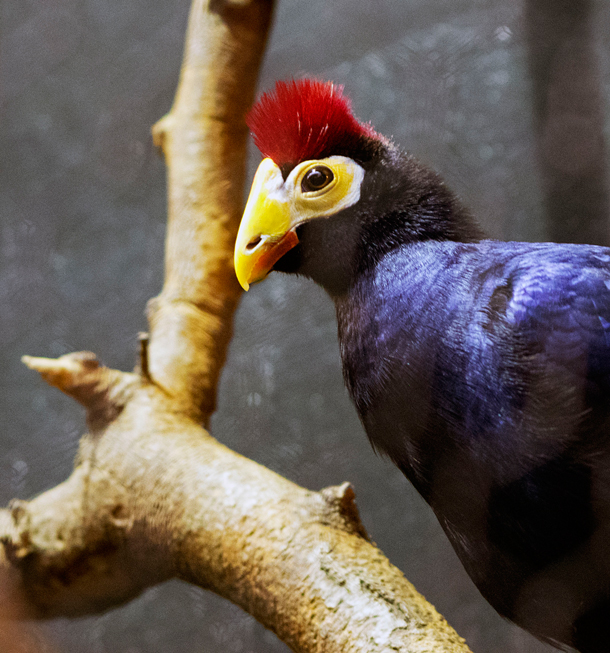
A fully-grown Lady Ross’ Turaco from the Cincinnati Zoo. (Photo: David Ellis, Flickr, CC BY-NC-ND 2.0)
BASCOMB: It’s Living on Earth, I’m Bobby Bascomb
CURWOOD: And I’m Steve Curwood
Around the world, zoos, aquariums, and wildlife centers have had to close their doors to the public in an effort to slow the spread of the novel coronavirus. In a few minutes, we’ll talk with the CEO of the New England Aquarium, who is one of the many zoo and aquarium leaders and staff who are working hard to care and provide for their animals, without the support of visitor revenues. But thanks to the internet you can still visit zoos and aquariums, as many facilities have gone online engaging folks with glimpses behind the scenes of how animals are keeping busy without daily visitors. Living on Earth’s Aynsley O’Neill has more.
O’NEILL: Zoos, aquariums, and wildlife centers across the country are doing more than ever before to provide virtual content, both educational and entertaining, for would-be patrons everywhere.
The Cincinnati Zoo hosts a daily Home Safari aimed at children who are stuck at home. They can meet an animal, like the newborn Lady Ross’ turaco chick. At nearly two months old, the chick is starting to pick up some of her adult colorings, with metallic blue feathers peeking through her black fuzz.
HANDLER: By the way, so this turaco, unfortunately, her mother passed away. And the next day we discovered there was an egg in there. And the mother – we went to take the egg to put it in an incubator, and she started hatching right in one of the curator’s hands, Jenny’s hands. Some of her favorite items here are these soaked pear pellets that we’re feeding now. Little bits of banana here, and grape, and papaya. You’re looking right into the camera there? Here you go. Have some more.
O’NEILL: When the home safari is done, the Cincinnati zoo gives instructions for a relevant craft project. A fully-grown Lady Ross’ turaco has a crown of bright red feathers – so the kids are encouraged to use materials around the house to make a crown to match. The Los Angeles zoo takes arts and crafts to another level with an endangered species draw-along with Brian Kesinger, an illustrator for Walt Disney Studios. He takes his audience step-by-step through his process for drawing a California Condor.
KESINGER: You can see how much even I am observing the actual animal, even though I’ve drawn for, you know, a long time, almost 30 years. I’m still always going back and learning and looking at all these cool wrinkles around the mouth. So, I’m going to go ahead, and you can do this too. Add just a little, little line, kind of curving up that way, and then down this way. (31 seconds)
O’NEILL: Like the Condor, every animal Brian draws is one that the LA Zoo is helping to save from extinction. There’s also the Wildlife Images Rehabilitation and Education Center in Grant’s Pass, Oregon. They post behind-the-scenes updates, so anyone can read about the dramatic rescue of two great horned owl chicks, or watch as a recently rehabilitated squirrel is given her lunch.
CARETAKER: We’re going to bring the baby squirrel out here. She came in about ten days ago, and she’s still on formula. She gets fed three times a day.
[SQUIRREL EATING NOISES]
O’NEILL: And countless zoos and wildlife centers around the country are offering live camera feeds into the animal exhibits. So you can virtually visit the Smithsonian National Zoo to get your giant panda fix, or the Bronx Zoo to watch lemurs frolic. And at-home access isn’t just for land animals – sea creatures are getting plenty of attention as well. The Georgia Aquarium is posting its own live streams and educational programming. And they’re also holding storytime with children’s picture books, and virtual yoga sessions in front of their Ocean Voyager exhibit.
INSTRUCTOR: For everyone on this planet who’s going through something together, send out that intention. Cultivate that attitude. May all people everywhere be happy. May all people everywhere be healthy. May all people everywhere be filled with loving-kindness.
O’NEILL: And the New England Aquarium is hosting live question and answer sessions on their social media, as well as providing virtual experiences like watching a harbor seal get its teeth brushed – or even taking a dive inside the Giant Ocean Tank.
[GIANT OCEAN TANK NOISES]
O’NEILL: For Living on Earth, I’m Aynsley O’Neill.
Related links:
- More from the Cincinnati Zoo & Botanical Garden
- More from the Los Angeles Zoo & Botanical Gardens
- More from the Wildlife Images Rehabilitation and Education Center
- More from the Georgia Aquarium
- More from the New England Aquarium
Behind the Quarantine at the New England Aquarium

The entrance to the New England Aquarium on a summer day in 2017. With the current lockdown, no visitors have been to the aquarium since mid-March. (Photo: Wikimedia Commons, CC BY-SA 4.0)
CURWOOD: To find out what it’s like to manage a major public aquarium when it suddenly shuts down with no clear end in sight, we turn now to Vikki Spruill. She’s president and CEO of the New England Aquarium in Boston. Vicki, welcome to Living on Earth!
SPRUILL: Hi, Steve, it's great to be here.
CURWOOD: First of all, where are you right now? And how are you dealing with social distancing?
SPRUILL: Well I, like millions of other Americans, am sitting in a makeshift home office in a suburb of Boston, Massachusetts, where I live.
CURWOOD: That's not your favorite place to be right now running an aquarium, I imagine.
SPRUILL: No, my favorite place would be to be downtown and to sneak over to the main building of our aquarium and stand there and watch all the kids with their noses to the glass, admiring our 20,000 animals. That's what I wish I was doing.
CURWOOD: 20,000 creatures.
SPRUILL: Yeah.
CURWOOD: And ranging in size from?
SPRUILL: Oh, itty bitty little fishes all the way up to our grande dame, Myrtle the turtle.
CURWOOD: So, with the aquarium closed during this pandemic crisis, how are the animals?
SPRUILL: So the animals are being cared for by an amazing team of aquarists and our animal care team. We have about 30 staff in the building now. They are considered essential personnel. And they go in there every day and continue to train and feed and take care of the medical needs of our wonderful animals. We're a little bit unusual as compared to other cultural institutions and museums in that when we close our doors, we still have to take care of the animals. And so, it's been quite challenging to figure it all out. But I'm also just deeply, deeply grateful, and impressed with the team that's pulled this together.
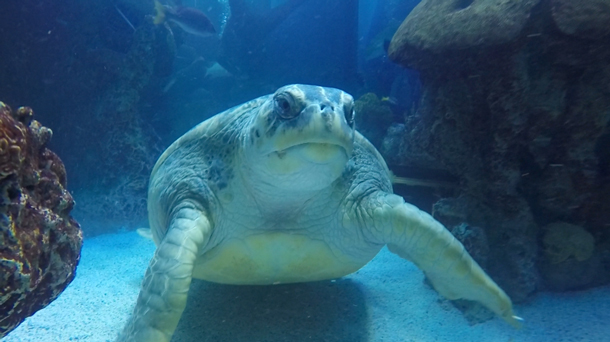
Myrtle the Turtle, a giant green turtle who resides in the New England Aquarium’s Giant Ocean Tank. (Photo: Courtesy of New England Aquarium)
CURWOOD: You've been posting some virtual visits from the aquarium, letting anyone who wants to spend some time in the company of your outfit from the safety of quarantine. How is it trying to transition to physical experiences, such as petting a stingray or feeling the splash of water as a little turtle swims by in some of those tables you have? How do you change that into a virtual experience?
SPRUILL: Well, it's funny when we closed, our members and our visitors, were asking the same question you asked, which is how are the animals, and we knew it would be important to keep that experience alive for them. And because we have staff there, already caring for the animals, we knew we could take that experience to them directly. So, we began to videotape and use our phones to share the everyday experiences that happen behind the scenes, as our staff is caring for the animals. And I, I don't think any of us expected to have the kind of reaction we've had. People have just loved it. And we locked into a regular slot every morning at 11 am. And, and then in the afternoon, we're creating an educational opportunity for kids that links back to what they saw that morning. And the numbers are through the roof in terms of followers and people who are signing up and watching every day, it's so heartening,
CURWOOD: Now, which are the animals, by the way, have noticed that they maybe are being streamed and are looking maybe for further acting roles.
SPRUILL: So, of course, there's Myrtle the turtle. She's been with us since almost the beginning of the aquarium, 50 years ago. And we're not quite sure how old she is, but we put her close to 90, and she rules the roost and still does, loving the camera and loving the attention.
CURWOOD: What are you missing the most from the aquarium right now? Is it those penguins waddling in the front? Is it the smell of fresh fish? What's going on?
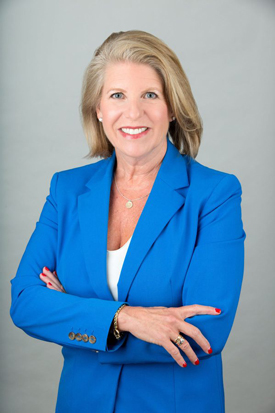
Vikki Spruill is the President and CEO of the New England Aquarium. (Photo: Courtesy of New England Aquarium)
SPRUILL: I think I miss the visitors. I miss the animals, but I see them through our virtual programming. I know they're being well taken care of. I miss our visitors because that's the lifeblood of our institution. And, you know, 80% of our revenue is derived from our special events and from the visitors who come through the door. And so, it's a sobering moment when one's revenue source is completely shut down. And that's what's happening to us and to so many other businesses. And you know, typically if a crisis happens in one part of the country, say a storm or a hurricane or something, we're a very tight-knit network of institutions who help one another with taking the animals if we have a particular challenge and whatnot. This is a little different because we're all in the same boat. And I think that's why it's so important for all of us to be able to have the resources to continue to shelter our animals in place and take care of them.
CURWOOD: So, it's been a very tough time. Tell me about a moment where it wasn't so tough. It was, in fact, maybe wonderful.
SPRUILL: That moment has to be when I went into the building after we'd closed, I went to thank our staff who are there, taking care of the animals. I was walking around the Giant Ocean Tank and Myrtle, our giant green turtle came and I swear she was looking at me. And I asked our Vice President for Animal Care who was with me if she thought the animals missed the people. And she said I think they might because they're so used to the human interaction that they have. And it was such a lovely moment to realize that this interaction between me and this, you know, an amazing turtle that we've cared for all these years, it was a connection. And it just made me realize and remember why I do what I do and why that beloved institution exists.
CURWOOD: Vikki Spruill is the CEO and President of the New England Aquarium. Vikki, thank you so much for taking the time with us today.
SPRUILL: Thank you, Steve.
CURWOOD: For links to the online tours and events hosted by the New England Aquarium and the institutions Aynsley mentioned earlier visit the living on earth website, loe.org
Related link:
More from the New England Aquarium
[MUSIC: T-Bone Walker, “Mean Old World” on T-Bone Blues, Atlantic Recording Corp.]
Sap-Iens: Yellow-Bellied Sapsuckers
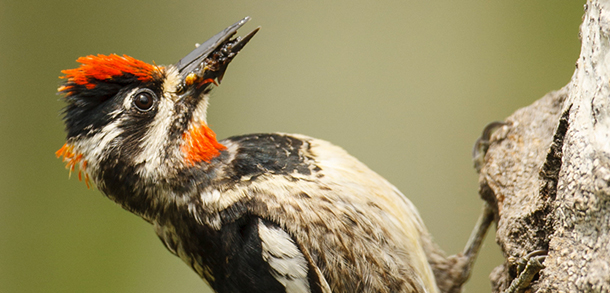
A mouth full of ants for the young ones. (Photo: © Mark Seth Lender)
BASCOMB: Spring is, of course, a busy time for birds. Once they’ve finished their migrations it’s time to get down to the serious business of finding a mate, building a nest, and raising chicks. As our Explorer in Residence Mark Seth Lender found in Lake Logan, British Columbia the short season for raising young in the far North means birds there have to work fast.
Sapiens
Yellow-bellied Sapsucker
Lake Logan, British Columbia
© 2020 Mark Seth Lender
All Rights Reserved
He is working as fast as he can. Hammering reshaping creating space, where there was none. Works as hard as he can. Rest is not his friend nor time North of a rigid line wherein a good year spring and the incipient chill of winter is no more than sixty days apart, everything doing is done with a start.
There are already young in the nest and them… will not… wait.
Yellow-bellied Sapsucker, in the season when life renews itself and the world again is green, never gets to sit on the shelf. Leisure? Not for him, not for the one who is his mate. At her own hectic pace shuttles back and forth, forth and back with insects in her mouth. Today’s special ants by the baker’s dozen, their armor burnished and shimmering. She squeezes (groceries and all) into the opening that is perfectly round and perfectly small to feed a colony of her own.
Then out.
Then off.
Again, for something else.
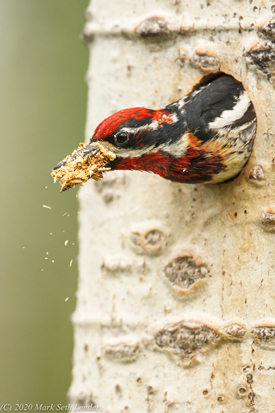
The carpenter at work. (Photo: © Mark Seth Lender)
Between these winged deliveries, Yellow-bellied Sapsucker tucks inside, craftsman, designer, laborer all in one. Minutes later shows his face, beak as full of sawdust as it can be, grains falling the length of the tree. Then off and away to hide the telltale signs of all he has done, all his colors flashing - black white deep crimson yellow - as if illumined by the final glow of the sun.
Though the day is less than halfway.
And will end too soon.
And not soon enough.
The baby birds grow and grow at an exponential pace. He wants to stop he wants to work and needs to sustain himself, all three in contradiction. But there it is. The builder inside him always wins. That is his way. He is responsible. The future depends on him.
This he knows. His persistence tells you so.
Orchids are flowering under the pines, and in the open field stands of wildflowers host the urgent dance of fritillaries bartering for nectar in exchange for the pollen that they bring. The song sparrow and the sparrow hawk conjoin in an unequal embrace. A yellow-headed blackbird lands calling his throaty call, the cattails swaying under him. Marsh wrens bend cattail leaves into a basket that will be their homestead. The lynx crosses the shallow stream, his round wide paws barely splashing. He climbs the bank that is low but steep and into the trees.
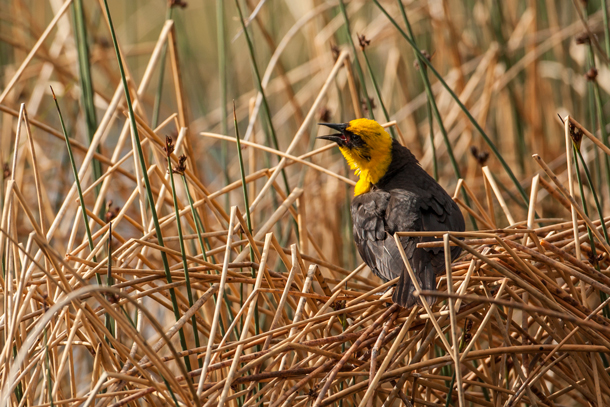
A male yellow-headed blackbird sings throatily. (Photo: © Mark Seth Lender)
At a distance, a moose and her calf watch the lynx retreat, wary, weary for all that the coming seasons will demand.
Inside the yet unfinished nest, Yellow-bellied Sapsucker closes his eyes and for a brief while, without having to spread his wings, takes flight.
BASCOMB: That’s Living on Earth’s Explorer in Residence, Mark Seth Lender. For photos from Mark’s trip head over the Living on Earth website, LOE.org.
Related links:
- Mark Seth Lender’s website
- About Destination Wildlife
[MUSIC: Michael Ottosson, “A Place To Call Home” on Three Waltzes, In Time Music]
CURWOOD: Living on Earth is produced by the World Media Foundation. Our crew includes Naomi Arenberg, Paloma Beltran, Thurston Briscoe, Jenni Doering, Jay Feinstein, Merlin Haxhiymeri, Candice Siyun Ji, Don Lyman, Isaac Merson, Aynsley O’Neill, Jake Rego, and Jolanda Omari.
BASCOMB: Tom Tiger engineered our show. Alison Lirish Dean composed our themes. Special thanks this week to Destination Wildlife. You can hear us anytime at L-O-E dot org, Apple Podcasts, and Google Podcasts and like us, please, on our Facebook page - Living on Earth. We tweet from @livingonearth. And find us on Instagram at livingoneartheradio. I’m Bobby Bascomb.
CURWOOD: And I’m Steve Curwood. Thanks for listening!
ANNOUNCER: Funding for Living on Earth comes from you, our listeners, and from the University of Massachusetts, Boston, in association with its School for the Environment, developing the next generation of environmental leaders. And from the Grantham Foundation for the protection of the environment, supporting strategic communications and collaboration in solving the world’s most pressing environmental problems. Support also comes from the Energy Foundation, serving the public interest by helping to build a strong, clean, energy economy.
ANNOUNCER 2: PRX.
Living on Earth wants to hear from you!
Living on Earth
62 Calef Highway, Suite 212
Lee, NH 03861
Telephone: 617-287-4121
E-mail: comments@loe.org
Newsletter [Click here]
Donate to Living on Earth!
Living on Earth is an independent media program and relies entirely on contributions from listeners and institutions supporting public service. Please donate now to preserve an independent environmental voice.
NewsletterLiving on Earth offers a weekly delivery of the show's rundown to your mailbox. Sign up for our newsletter today!
 Sailors For The Sea: Be the change you want to sea.
Sailors For The Sea: Be the change you want to sea.
 The Grantham Foundation for the Protection of the Environment: Committed to protecting and improving the health of the global environment.
The Grantham Foundation for the Protection of the Environment: Committed to protecting and improving the health of the global environment.
 Contribute to Living on Earth and receive, as our gift to you, an archival print of one of Mark Seth Lender's extraordinary wildlife photographs. Follow the link to see Mark's current collection of photographs.
Contribute to Living on Earth and receive, as our gift to you, an archival print of one of Mark Seth Lender's extraordinary wildlife photographs. Follow the link to see Mark's current collection of photographs.
 Buy a signed copy of Mark Seth Lender's book Smeagull the Seagull & support Living on Earth
Buy a signed copy of Mark Seth Lender's book Smeagull the Seagull & support Living on Earth

